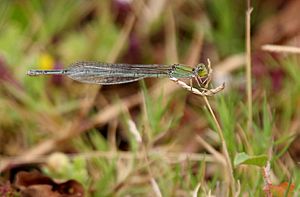Coenagrionidae facts for kids
Quick facts for kids Coenagrionidae |
|
|---|---|
 |
|
| Male Ceriagrion glabrum | |
| Scientific classification |
|
| Kingdom: | Animalia |
| Phylum: | Arthropoda |
| Class: | Insecta |
| Order: | Odonata |
| Suborder: | Zygoptera |
| Superfamily: | Coenagrionoidea |
| Family: | Coenagrionidae Kirby, 1890 |
| Diversity | |
| at least 110 genera | |
The insect family Coenagrionidae is a group of insects that belong to the larger order called Odonata. Within Odonata, they are part of the suborder known as Zygoptera, which are the damselflies.
Even though they are not as famous as dragonflies, damselflies are very common. This family has over 1,300 different kinds of species, making it the biggest damselfly family in the world! The Coenagrionidae family is divided into six smaller groups called subfamilies: Agriocnemidinae, Argiinae, Coenagrioninae, Ischnurinae, Leptobasinae, and Pseudagrioninae.
People often call this family the "narrow-winged damselflies" or "pond damselflies." You can find Coenagrionidae all over the world, and they are some of the most common damselflies you will see. This family also includes the smallest damselfly species. Today, scientists recognize more than 110 different groups, or genera, within the Coenagrionidae family.
What's in a Name?
The name Coenagrionidae likely comes from ancient Greek words. Coen means "shared" or "common," and agrio means "fields" or "wild." So, it might mean "common wild damselflies."
Cool Features
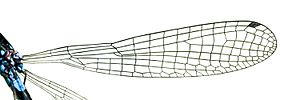
Coenagrionidae damselflies have some special features:
- They often have a black pattern on their bodies.
- Their main body color can be green, blue, yellow, orange, or even purple!
- Their wings are usually narrow, clear, and look like they have a stalk at the base.
- They have two special veins near the front of their wings called antenodal cross veins.
- Another vein, called M3, starts closer to the middle of the wing (the nodus) than to the base (the arculus).
You can usually spot adult damselflies from this family near water, like ponds and wetlands. The females lay their eggs on plants, either living or dead, that are underwater. Some species can even crawl underwater to lay their eggs! The young damselflies, called nymphs, usually hide among underwater plants or debris.
Different Kinds of Damselflies
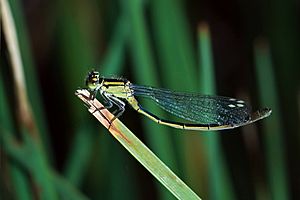
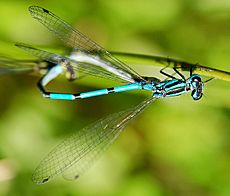
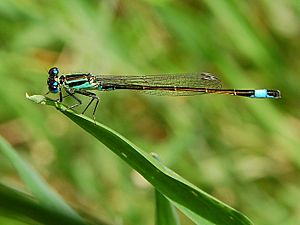
Here are some of the many different groups (genera) that belong to the Coenagrionidae family:
- Acanthagrion Selys, 1876
- Acanthallagma Williamson & Williamson, 1924
- Aceratobasis Kennedy, 1920
- Aciagrion Selys, 1891
- Aeolagrion Williamson, 1917
- Africallagma Kennedy, 1920
- Agriocnemis Selys, 1877
- Amazoneura Machado, 2004
- Amphiagrion Selys, 1876 (red damsels)
- Amphiallagma Kennedy, 1920
- Amphicnemis Selys, 1863
- Andinagrion Bulla, 1973
- Angelagrion Lencioni, 2008
- Anisagrion Selys, 1876
- Anomisma McLachlan, 1877
- Antiagrion Ris, 1904
- Apanisagrion Kennedy, 1920
- Archibasis Kirby, 1890
- Argentagrion Fraser, 1948
- Argia Rambur, 1842 (dancers)
- Argiocnemis Selys, 1877
- Austroagrion Tillyard, 1913
- Austroallagma Lieftinck, 1953
- Austrocnemis Tillyard, 1913
- Austrocoenagrion Kennedy, 1920
- Austrotepuibasis Machado & Lencioni, 2011
- Azuragrion May, 2002
- Bromeliagrion De Marmels, 2005
- Caliagrion Tillyard, 1913
- Calvertagrion St. Quentin, 1960
- Ceriagrion Selys, 1876
- Chromagrion Needham, 1903 (aurora damsels)
- Coenagriocnemis Fraser, 1949
- Coenagrion Kirby, 1890 (Eurasian bluets)
- Coryphagrion Morton, 1924
- Cyanallagma Kennedy, 1920
- Denticulobasis Machado, 2009
- Diceratobasis Kennedy, 1920
- Dolonagrion Garrison & von Ellenrieder, 2008
- Drepanoneura von Ellenrieder & Garrison, 2008
- Enacantha Donnelly & Alayo, 1966
- Enallagma Charpentier, 1840 (American bluets)
- Epipleoneura Williamson, 1915
- Epipotoneura Williamson, 1915
- Erythromma Charpentier, 1840
- Fluminagrion Anjos-Santos, Lozano & Costa, 2013
- Forcepsioneura Lencioni, 1999
- Franciscagrion Machado & Bedê, 2016
- Franciscobasis Machado & Bedê, 2016
- Hesperagrion Calvert, 1902 (painted damsels)
- Hivaagrion Hämäläinen & Marinov, 2014
- Homeoura Kennedy, 1920
- Huosoma Guan, Dumont, Yu, Han & Vierstraete, 2013
- Hylaeonympha Rácenis, 1968
- Idioneura Selys, 1860
- Inpabasis Santos, 1961
- Ischnura Charpentier, 1840 (forktails)
- Junix Rácenis, 1968
- Lamproneura De Marmels, 2003
- Leptagrion Selys, 1876
- Leptobasis Selys, 1877 (swamp damsels)
- Leptocnemis Selys, 1886
- Leucobasis Rácenis, 1959
- Luzonobasis Villanueva, 2012
- Mecistogaster Rambur, 1842
- Megalagrion McLachlan, 1883
- Megaloprepus Rambur, 1842
- Melanesobasis Donnelly, 1984
- Mesamphiagrion Kennedy, 1920
- Mesoleptobasis Sjöstedt, 1918
- Metaleptobasis Calvert, 1907
- Microstigma Rambur, 1842
- Millotagrion Fraser, 1953
- Minagrion Santos, 1965
- Mortonagrion Fraser, 1920
- Nehalennia Selys, 1850 (sprites)
- Neoerythromma Kennedy, 1920 (yellowfaces)
- Neoneura Selys, 1860 (robust threadtails)
- Nesobasis Selys, 1891
- Oreiallagma von Ellenrieder & Garrison, 2008
- Oreocnemis Pinhey, 1971
- Oxyagrion Selys, 1876
- Oxyallagma Kennedy, 1920
- Pacificagrion Fraser, 1926
- Pandanobasis Villanueva, 2012
- Papuagrion Ris, 1913
- Paracercion Weekers & Dumont, 2004
- Pericnemis Selys, 1863
- Peristicta Hagen in Selys, 1860
- Phasmoneura Williamson, 1916
- Phoenicagrion von Ellenrieder, 2008
- Pinheyagrion May, 2002
- Plagulibasis Lieftinck, 1949
- Platystigma Kennedy, 1920
- Proischnura Kennedy, 1920
- Proneura Selys, 1889
- Protallagma Kennedy, 1920
- Protoneura Selys in Sagra, 1857
- Psaironeura Williamson, 1915
- Pseudagrion Selys, 1876
- Pseudostigma Selys, 1860
- Pyrrhosoma Charpentier, 1840
- Roppaneura Santos, 1966
- Sangabasis Villanueva, 2012
- Schistolobos von Ellenrieder & Garrison, 2008
- Stenagrion Laidlaw, 1915
- Teinobasis Kirby, 1890
- Telagrion Selys, 1876
- Telebasis Selys, 1865 (firetails)
- Tepuibasis De Marmels, 2007
- Thaumatagrion Lieftinck, 1932
- Tigriagrion Calvert, 1909
- Tuberculobasis Machado, 2009
- Tukanobasis Machado, 2009
- Vanuatubasis Ober & Staniczek, 2009
- Xanthagrion Selys, 1876
- Xanthocnemis Tillyard, 1913
- Xiphiagrion Selys, 1876
- Zoniagrion Kennedy, 1920
See also
 In Spanish: Cenagriónidos para niños
In Spanish: Cenagriónidos para niños



